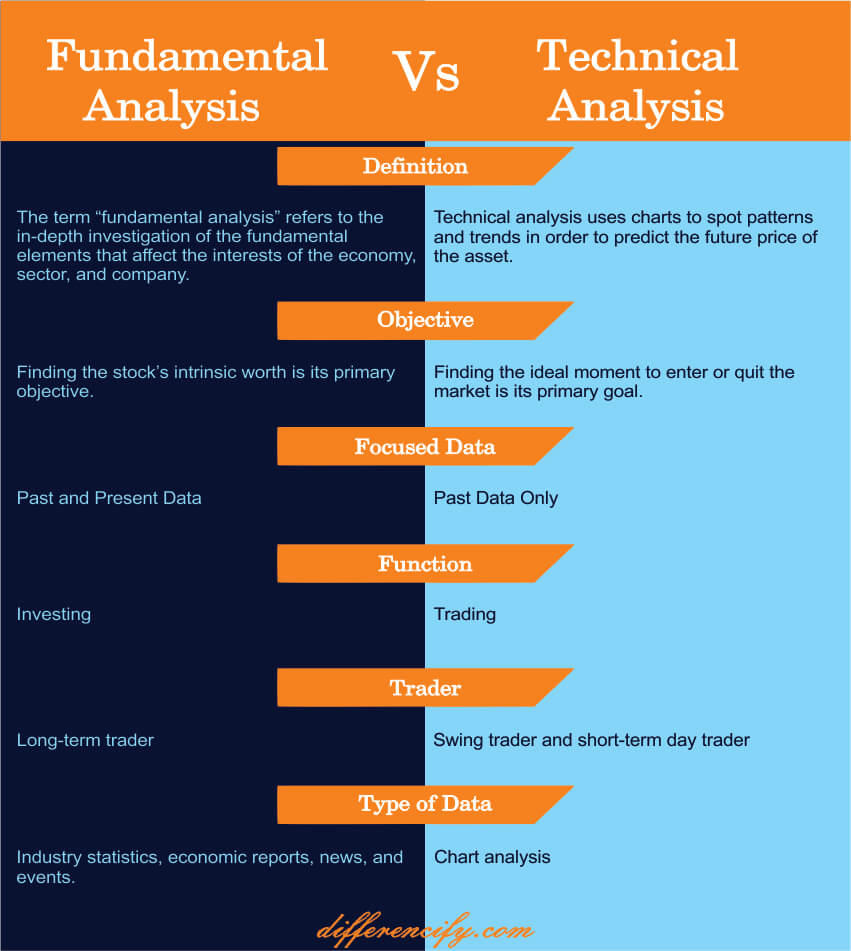Difference Between Fundamental and Technical Analysis(With Table)
Technical Analysis tools are used by traders in order to forecast the movements of a security based on past price and volume data. Investors who make decisions only on the basis of fundamental analysis, or who rely solely on technical analysis, are not making an informed decision. Fundamental analysts use data gleaned from the company’s balance sheet to evaluate the company. Technical analysts examine charts of a security’s past prices and trading volume to estimate its future performance. The following blog will help us understand the difference between fundamental and technical analysis.
What is Fundamental Analysis?
Fundamental analysis is a method of evaluating a security by analyzing the financial statements of the company that issued it. This type of analysis looks at factors such as the company’s earnings, revenue, debts, and other financial indicators to determine its intrinsic value. The fundamental analysis assesses the company’s financial health and its potential for future growth.
Moreover, the fundamental analysis also takes into account economic and political factors that could affect the security price. For example, if a company is located in a country with high political risk, this would be considered when assessing the company’s intrinsic value.
Lastly, fundamental analysis is a long-term approach to security valuation and it is not concerned with short-term price movements. The three main parts of an analysis of fundamental analysis are described as follows:
- The economy – The first step in fundamental analysis is to assess the overall health of the economy. This includes evaluating economic indicators such as gross domestic product (GDP), inflation, unemployment, and interest rates. These indicators can give insights into whether the economy is in an expansionary, recessionary, or stable phase.
- The industry – The next step is to analyze the specific industry in which the company operates. This includes looking at factors such as industry growth rates, competitive landscape, and regulatory environment. Industry analysis can help to identify companies that are well-positioned to benefit from favorable industry trends.
- The company – Finally, the last step is to evaluate the financial statements of the company itself. This includes looking at measures such as earnings, revenue, debts, and cash flow. Financial statement analysis can give insights into a company’s profitability and solvency.
What is Technical Analysis?
Technical analysis, on the other hand, is a method of evaluating securities by analyzing the market data related to them. This data includes things like price history, trading volume, and open interest. Technical analysts use this information to try to predict future price movements.
There are a variety of different technical analysis techniques that traders can use, but some of the most popular include trend analysis, support and resistance levels, and moving averages.
The following described tools can be used for technical analysis:
- Trend Analysis – This is a technique that attempts to predict the future price movement of a security by looking at its past price movements. This can be done by looking at things like price charts and technical indicators.
- Support and Resistance Levels – Support and resistance levels are important concepts in technical analysis. These are levels where the price of a security has difficulty breaking through in either direction. These levels can be used to try to predict future price movements.
- Moving Averages – A moving average is an indicator that is used to smooth out price data. This can help to make it easier to identify trends. There are different types of moving averages, but the most common are simple moving averages and exponential moving averages.
Fundamental Vs Technical Analysis(Comparison Table)

Key Differences Between Fundamental and Technical Analysis
- A method of studying security in order to determine its intrinsic worth for long-term investment prospects is called fundamental analysis. Contrarily, technical analysis is a technique for assessing and predicting a security’s price in the future based on price movement and transaction volume. It forecasts a stock’s future behavior.
- Fundamental analysis focuses on a company’s underlying business fundamentals, such as its earnings, revenue, and debt. Technical analysis, on the other hand, looks at past price patterns to try to predict future price movements.
- Fundamentalists believe that a stock’s price reflects all relevant information about a company, while technical analysts think that prices move in trends and that these trends can be identified and exploited.
- While fundamental analysis is generally used to find long-term investments, technical analysis is more often used for short-term trading.
- Fundamentalists tend to rely more on company financial statements and economic indicators. On the other hand, technical analysts focus more on charts and other market data.
- Fundamental analysis is primarily concerned with a company’s prospects for growth, while technical analysis is mostly concerned with identifying trends in the market.
- Many fundamentalists consider technical analysis to be little more than guesswork, while many technical analysts view fundamental analysis as too slow to be of any use in making trading decisions.
- Both fundamental and technical analysis have their pros and cons, and many investors use both approaches in combination to make investment decisions.
Conclusion
Both fundamental and technical analysis have their pros and cons, but which one is right for you depends on your investment goals and style. If you’re looking to buy a stock and hold it for the long term, then fundamental analysis is probably the way to go. But if you’re more interested in short-term trading, then technical analysis might be more your speed.



One Comment